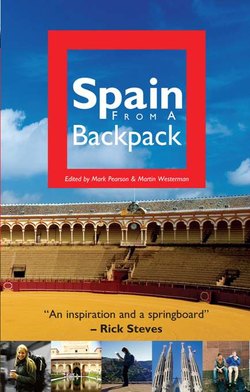Читать книгу Spain from a Backpack - Mark Pearson - Страница 6
На сайте Литреса книга снята с продажи.
ОглавлениеIntroduction
Welcome to Spain, the Iberian Peninsula, the 12th-century western border of the Moorish Empire, jump-off point to mysterious Africa. You hold the gateway in your hands: By opening Spain From a Backpack, you are transporting yourself for the next marvelous moments to the España of blocky Basque castles, intricate Moorish designs and fanciful Gaudi creations. And welcome to a different pace of life—a pace informed by centuries of artful and bloody history, where we rise and start work early, siesta in the afternoon, and stay up late. We shop for our food every few days in open-air markets, for olives and tapenade, crusty breads, cheeses, meats, fresh tomatoes and garlic, and we cook for the joy of it. We go out for tapas in the evening, then dine in leisure, never bothered by waiters repeatedly asking, “May I take your plate?”
This is how our book series started: My co-editor, Mark Pearson, observed lots of Europe guidebooks on the market, all explaining where to go and what to do, but few books that tell what it’s like to actually be in Europe; and virtually none written by and for backpackers. These twenty- or thirty-somethings carry their worldly possessions on their backs, traveling on a shoestring budget. Backpackers decide each day where they will go and what they will do, and, often, they experience marvels that elude people who carry suitcases and make reservations. Every year, nearly two million American, and hundreds of thousands of British, Canadian and Australian, backpackers are drawn to Europe for travel, study and work.
Fresh from studying in and backpacking around Europe himself, Mark put out the word for stories on the Web, and, to date, we have received more than 1,000 submissions from around the world. He approached me to edit the first collection, Europe From a Backpack: Real Stories from Young Travelers Abroad, and the more I read, the more I realized we had to do these books. We select the stories based on simple criteria: well-written, authentic, first-hand. And each one brings back wonderful memories for each of us.
For me, it’s when I first knocked around Europe as a young man just out of the Coast Guard. I grew long hair and a beard, and hitchhiked with my buddy Craig out of London and across the continent, to end up picking oranges and grapefruit on a kibbutz in northern Israel. I started calling myself a “United Statian,” because calling myself an “American” seemed presumptuous, since everybody else from every other country in our hemisphere is American, too. These were months of new tastes and aromas, surprising characters, awesome horizons, adventures and discoveries; of exploration and growth.
Europe, the first book in our series, covered a wide range of travelers, juvenile to mature, and a wide range of subjects, simple to complex: the Berlin art scene, life and death on a Scottish farm at lambing season, and finding love again as a couple in Budapest. One was a serious art student seeking the right color for sky blue, for a painting class near the Eiffel Tower, when a despondent Frenchman jumped off its top. Others were party animals and thrill seekers (one snuck into the Roman Colosseum in one story, and flipped his Spanish rental car in another). Some just wanted comfort for their homesickness, as did the student who discovered an all-American Christmas in snowbound Lublijana, Slovenia.
Now, in this second book of our series, Spain From a Backpack, we meet a fresh group of young writers who take us through the flavors and characters of Iberia. They follow in the footsteps of Hemingway—running with the bulls in Pamplona, drinking local wine, fighting a war in Buñol (well, for an hour, with 90,000 pounds of tomatoes). But they also blaze their own trails.
One young woman fights through the weather and pain of the 800-kilometer Camino de Santiago pilgrimage, and transforms her life (“To Be a Pilgrim”). Two men just out for a picnic dinner in the beach dunes become the lightning rods for coleoptera beetles (“A Few Climb Up My Shorts”).
Some come to Spain seeking ways they can integrate into the culture, and perhaps even become Spanish, through dance (“Finding My Duende”) or family (“Meeting Pepe’s Mom”). Others resist integrating (“Bang, Bang! The Butane Man”) or actively fight it (“Robbed in the Rastro”).
Some happen upon an appreciation of the culture by accident, in their train car (“Eight to a Compartment”); some fall in love with it and get married (“Running for the Boy”); some just poke their heads into it (“Miguel’s Bar”), and some are shut out of it completely (“The Curse of the Tassled Loafers”).
Overall, these stories tell us what the guidebooks don’t: how to live on the ground once we arrive. We not only get the thrill of living vicariously through someone else’s travels—enjoying fond memories if we have traveled, and getting inspired if we haven’t—but we also learn, through the hindsight these travelers provide, wisdom about what to do and what not to do when we actually get there. The book serves as a tantalizing foretaste of what awaits us, and as an escape from our daily lives; a refreshing break from the ordinary.
As one of our readers noted, “This collection should inspire any traveler to record their memories in a journal. A few unforgettable travel anecdotes are far superior to a collection of a hundred photo slides to torture your friends and family with.”
Since the dawn of humans, we have loved good stories. So, we invite you to turn the page and indulge in this treasure trove of tales you’ve discovered.
Martin Westerman
www.europebackpack.com
